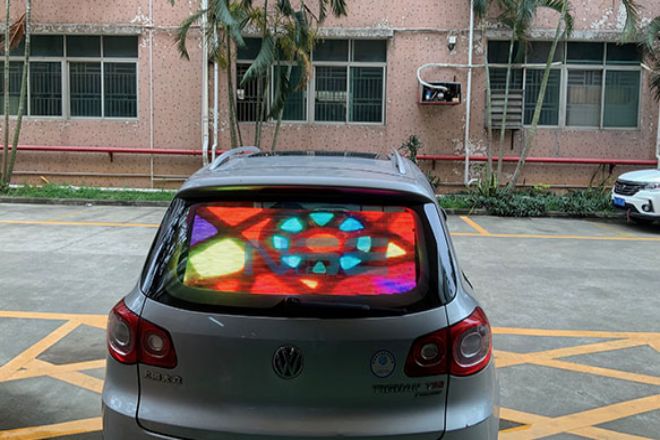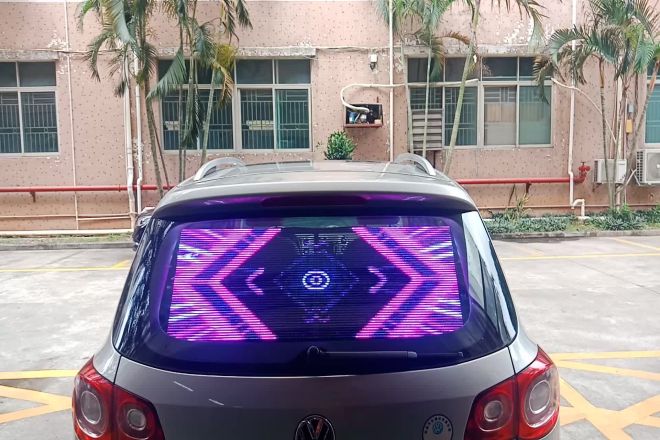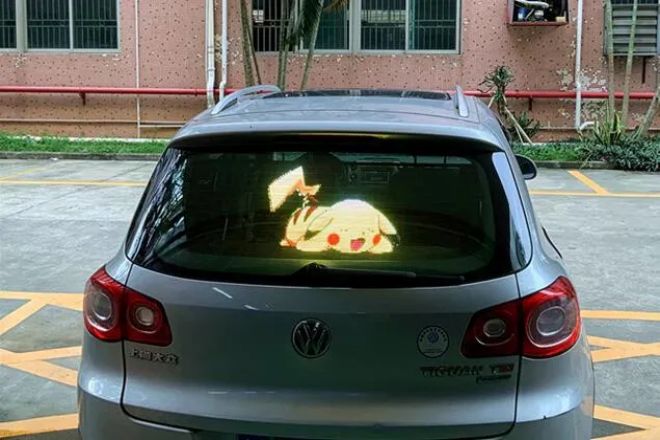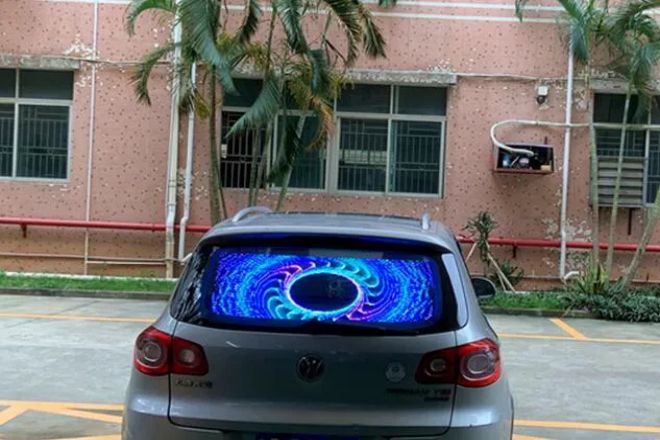Introduction

Avec le développement rapide de la science et de la technologie, Écrans d'affichage LED sont devenus un élément indispensable de notre vie. En particulier dans le domaine des transports, les écrans d'affichage LED pour vitres de voiture émergent progressivement avec leurs avantages uniques, tels que la nature en temps réel de la diffusion des informations, l'efficacité de la promotion publicitaire et la clarté de l'identification de l'identité du véhicule.
Ces écrans d’affichage facilitent non seulement nos déplacements, mais insufflent également une nouvelle vitalité au développement de l’image urbaine et de l’industrie publicitaire.
1. Composition de l'écran d'affichage LED de la fenêtre de la voiture

1). Partie matérielle
- Matrice de points LED :
La matrice de points LED est l'unité de base de l'écran d'affichage, qui est composée de plusieurs perles de lampe LED disposées selon une certaine règle. Chaque perle de lampe LED est une diode électroluminescente, qui émet de la lumière lorsque le courant la traverse. En contrôlant l'allumage et l'extinction de chaque perle de lampe LED, des effets d'affichage tels que du texte, des images et des animations peuvent être formés.
Principe de luminescence : Le principe de luminescence des LED repose sur l'effet électroluminescent des matériaux semi-conducteurs. Lorsque le courant direct traverse la jonction PN, les électrons et les trous se recombinent, libèrent de l'énergie et rayonnent sous forme de lumière. La couleur lumineuse de la LED dépend du type de matériau semi-conducteur et de l'élément dopant.
- Circuit de commande :
Le circuit de commande est l'élément clé du contrôle de l'allumage et de l'extinction de la matrice de points LED. Il est principalement composé d'un circuit de commande de ligne et d'un circuit de commande de colonne. En contrôlant l'allumage et l'extinction du commutateur de sélection, chaque ligne ou colonne de la LED est commandée de manière sélective pour contrôler l'allumage et l'extinction de la LED.
Technologie d'affichage en niveaux de gris : afin d'obtenir un effet d'affichage plus délicat, le circuit d'entraînement utilise généralement la technologie PWM (modulation de largeur d'impulsion) pour ajuster la luminosité de la LED, réalisant ainsi un affichage en niveaux de gris à plusieurs niveaux.
- Manette:
Le contrôleur est le composant principal de l'affichage LED des vitres de voiture et est responsable de la réception, du traitement et de l'envoi des informations d'affichage. Il reçoit les instructions d'affichage des périphériques ou systèmes externes, les convertit en signaux de commande adaptés au circuit de commande et contrôle l'allumage et l'extinction de la matrice LED via le circuit de commande.
- Système d'alimentation électrique :
Le système d'alimentation fournit une tension de fonctionnement stable pour l'écran. En raison de la particularité de l'environnement du véhicule, le système d'alimentation doit avoir une bonne stabilité et une capacité anti-interférence pour garantir que l'écran puisse fonctionner normalement dans divers environnements.
- Intégration de fenêtre :
L'écran LED de la fenêtre doit être étroitement intégré à la fenêtre pour une installation sans faille. Cela est généralement réalisé grâce à une structure de montage spécifique et à une technologie d'étanchéité pour assurer la stabilité et la sécurité de l'affichage sur la fenêtre.
2). Partie logicielle
- Logiciel d'édition de contenu d'affichage :
Le logiciel d'édition de contenu d'affichage est utilisé pour éditer et concevoir le contenu d'affichage. Les utilisateurs peuvent saisir du texte, des images, des animations et d'autres informations via le logiciel, et définir des paramètres tels que le mode d'affichage et la vitesse de lecture. Après l'édition, le logiciel génère les instructions d'affichage correspondantes et les envoie au logiciel du système de contrôle.
- Logiciel du système de contrôle :
Le logiciel du système de contrôle est un pont reliant le logiciel d'édition du contenu de l'affichage et le matériel. Il reçoit les instructions d'affichage du logiciel d'édition, les convertit en signaux de commande adaptés au circuit de commande et contrôle l'allumage et l'extinction de la matrice de points LED via le circuit de commande. Le logiciel du système de contrôle est également responsable de la gestion de l'état de fonctionnement, du diagnostic des pannes et du protocole de communication de l'écran d'affichage.
- Protocole de communication :
Le protocole de communication est la règle de communication entre l'écran d'affichage et le périphérique ou le système externe. Il spécifie des paramètres tels que le format des données, le mode de transmission, le débit de communication, etc., pour garantir l'exactitude et la fiabilité des données pendant la transmission. Les protocoles de communication courants incluent RS232, RS485, TCP/IP, etc.
2. Principe de fonctionnement de l'écran d'affichage LED pour vitre de voiture
1). Processus d'affichage des informations
Le périphérique ou système externe envoie des informations d'affichage au contrôleur de l'écran d'affichage LED de la vitre de la voiture via un protocole de communication spécifique (tel que RS232, RS485, TCP/IP, etc.).
Après avoir reçu les informations, le contrôleur effectue d'abord un traitement de décodage pour convertir les données reçues en un signal de commande qui peut être reconnu par l'écran d'affichage.
Le circuit de commande contrôle l'allumage et l'extinction de chaque perle LED dans la matrice de points LED en fonction des instructions émises par le contrôleur afin de présenter le texte, les images, les animations et autres contenus prédéfinis sur l'écran d'affichage.
2). Contrôle de l'effet d'affichage
- Réglage de la luminosité :
La luminosité est l'un des paramètres clés de l'effet d'affichage. La luminosité de la LED peut être contrôlée avec précision en ajustant le courant qui circule à travers la LED ou en utilisant la technologie PWM (modulation de largeur d'impulsion). La technologie PWM permet de régler la luminosité en modifiant le cycle de marche/arrêt de la perle LED, ce qui est plus économe en énergie et plus stable.
- Fréquence de rafraîchissement:
Le taux de rafraîchissement fait référence au nombre de fois que l'écran d'affichage met à jour l'affichage par seconde. Un taux de rafraîchissement élevé signifie que le contenu affiché est plus fluide et réduit la fatigue visuelle. Les écrans LED modernes pour vitres de voiture ont généralement un taux de rafraîchissement élevé, par exemple 60 Hz ou plus, pour garantir une bonne expérience de visionnage.
- Affichage en niveaux de gris :
L'affichage en niveaux de gris fait référence au nombre de niveaux de luminosité différents que l'écran d'affichage peut présenter. Un affichage en niveaux de gris à plusieurs niveaux peut rendre l'image plus délicate et les couleurs plus riches. L'affichage en niveaux de gris à plusieurs niveaux peut être obtenu en contrôlant la combinaison marche/arrêt des billes LED et le réglage de la luminosité.
3). Conception économe en énergie et respectueuse de l'environnement
- Technologie d'économie d'énergie :
Utilisez des perles LED à faible consommation pour réduire la consommation électrique globale de l'écran d'affichage. Dans le même temps, l'algorithme intelligent d'économie d'énergie est utilisé pour ajuster automatiquement la luminosité et le temps de fonctionnement de l'écran d'affichage en fonction des besoins de lumière ambiante et du contenu de l'affichage, réduisant ainsi encore la consommation d'énergie.
- Matériaux respectueux de l'environnement :
Lors du processus de production de l'écran d'affichage, des matériaux respectueux de l'environnement tels que des plastiques recyclables et des revêtements non toxiques et inoffensifs sont sélectionnés pour réduire la pollution de l'environnement. De plus, le processus de production est optimisé pour réduire la consommation d'énergie et les émissions de déchets pendant le processus de production.
- Conception de dissipation thermique :
Étant donné que les LED génèrent de la chaleur lorsqu'elles fonctionnent, la conception de la dissipation thermique est essentielle pour maintenir la stabilité de l'écran d'affichage et prolonger sa durée de vie. En adoptant des dispositifs de dissipation thermique efficaces tels que des dissipateurs thermiques et des ventilateurs, assurez-vous que l'écran d'affichage peut maintenir une basse température pendant le fonctionnement.
3. L'alimentation de l'écran d'affichage LED de la vitre de la voiture est-elle fournie par le véhicule ?

L'alimentation de l'écran d'affichage LED de la vitre de la voiture est en effet fournie par le véhicule, et la méthode de fourniture spécifique est la suivante :
- Alimentation par batterie de voiture :
Lorsque le moteur du véhicule n'est pas démarré, l'énergie utilisée par l'écran LED de la vitre de la voiture est principalement fournie par la batterie de la voiture elle-même. En effet, à ce stade, le générateur ne fonctionne pas et l'équipement électronique de la voiture ne peut pas être alimenté.
- Alimentation du générateur de voiture :
Une fois le moteur du véhicule démarré, le générateur commence à fonctionner et alimente les équipements électroniques de la voiture. Par conséquent, à ce moment-là, l'alimentation de l'écran d'affichage LED de la vitre de la voiture est fournie par le générateur de la voiture. Cette méthode garantit que l'écran d'affichage fonctionne de manière continue et stable pendant le processus de conduite du véhicule.
- Consommation d'énergie et efficacité :
La consommation d'énergie de l'écran LED de la fenêtre de la voiture dépend de nombreux facteurs, tels que son type, sa luminosité, sa surface et le contenu de l'affichage. Par exemple, les écrans LED extérieurs consomment généralement plus d'énergie car des écrans plus lumineux sont nécessaires pour résister à la lumière du soleil. De plus, l'affichage d'un arrière-plan sombre peut consommer moins d'électricité, tandis que l'affichage d'une image colorée consomme plus d'électricité.
4. Scénarios d'application des écrans d'affichage LED pour vitres de voiture
- Les informations sur le trafic vous invitent à :
L'installation d'écrans LED sur les vitres des véhicules de transport en commun (bus, métro, etc.) permet d'afficher en temps réel les informations sur le trafic, telles que les itinéraires, les stations et les heures d'arrivée, offrant ainsi aux passagers des guides de voyage pratiques. Cela améliore non seulement l'expérience de voyage des passagers, mais contribue également à améliorer l'efficacité et la précision des transports publics.
- Publicité et promotion:
L'utilisation d'écrans d'affichage LED pour vitres de voiture sur les vitres des taxis, des voitures particulières, etc., offre un nouveau canal de promotion publicitaire. Le contenu publicitaire affiché sur l'écran d'affichage LED pour vitres de voiture peut attirer l'attention des passants pendant la conduite et assurer une diffusion à grande échelle de la publicité.
Cette forme de publicité présente les caractéristiques d'un fort impact visuel et d'une large couverture et convient à tous les types de commerçants pour réaliser la promotion de la marque, la promotion du produit et d'autres activités de marketing.
- Sauvetage d'urgence :
Dans des circonstances particulières, les véhicules de secours d'urgence tels que les voitures de police et les ambulances peuvent être équipés d'écrans LED de fenêtre pour afficher des informations d'urgence, telles que « Veuillez céder le passage » et « Secours d'urgence », afin que le public puisse les identifier et les éviter.
Cette application peut améliorer l'efficacité du trafic des véhicules de secours d'urgence, raccourcir le temps de sauvetage et fournir un soutien solide pour sauver des vies et réduire les pertes matérielles.
Dans le même temps, l'affichage LED de fenêtre peut également être combiné avec des équipements tels que des caméras embarquées et des systèmes de positionnement GPS pour obtenir des services de sauvetage d'urgence plus intelligents et plus efficaces.
5. Tendance de développement future de l'affichage LED de fenêtre

- Intelligence:
Avec le développement rapide des systèmes intelligents embarqués, les écrans LED des fenêtres seront étroitement intégrés à ceux-ci pour réaliser des fonctions plus intelligentes. Par exemple, en se connectant au système de navigation embarqué, l'écran peut afficher des informations de navigation en temps réel, notamment la planification d'itinéraire, les embouteillages, etc., pour offrir aux conducteurs une expérience de conduite plus pratique et plus intelligente.
De plus, l'écran LED intelligent peut également coopérer avec des capteurs, des caméras et d'autres équipements embarqués pour réaliser des fonctions avancées telles que l'assistance à la conduite automatique et la surveillance de l'état du véhicule. Par exemple, lorsque le véhicule détecte qu'une collision est sur le point de se produire, l'écran peut immédiatement afficher un message d'avertissement pour rappeler au conducteur de prendre des mesures en temps opportun.
- La flexibilité:
La technologie d'affichage LED flexible offre de nouvelles opportunités pour le développement d'écrans LED pour vitrines. Par rapport aux écrans rigides traditionnels, les écrans flexibles ont une plus grande flexibilité et plasticité et peuvent s'adapter à des conceptions de fenêtres de différentes formes et tailles.
À l'avenir, les écrans LED flexibles pour vitres pourront mieux s'intégrer à l'apparence du véhicule, ce qui permettra des méthodes d'installation plus esthétiques et plus flexibles. Par exemple, ils peuvent être conçus pour se fondre parfaitement dans la vitre de la fenêtre ou installés sur la porte ou le toit comme une bande décorative pliable.
- Personnalisation :
Avec l'augmentation des besoins personnalisés des consommateurs, les écrans LED pour fenêtres évoluent vers la personnalisation et la différenciation. Différents véhicules et différents propriétaires de voitures peuvent nécessiter différents contenus et styles d'affichage, les écrans LED pour fenêtres doivent donc offrir une plus grande personnalisation.
À l'avenir, les écrans LED de fenêtre prendront en charge davantage d'options de réglage personnalisées, telles que la personnalisation du contenu de l'affichage, le réglage de la luminosité de l'affichage, la modification du style d'affichage, etc. Cela permettra aux propriétaires de voitures de personnaliser leurs écrans LED de fenêtre en fonction de leurs préférences et de leurs besoins et d'obtenir une expérience de conduite plus personnalisée.
En résumé, les écrans LED de vitrine jouent un rôle de plus en plus important dans le domaine du transport grâce à leurs avantages uniques.
Conclusion
Du matériel au logiciel, des principes de fonctionnement aux scénarios d'application, chaque maillon reflète la sagesse et la puissance de la technologie moderne. À l'avenir, avec l'avancement et l'innovation continus de la technologie, les écrans LED pour vitres de voiture feront de plus grandes percées en matière d'intelligence, de flexibilité et de personnalisation, apportant plus de confort et de surprises à nos vies.
Enfin, si vous souhaitez en savoir plus sur les écrans LED, veuillez nous contacter.
